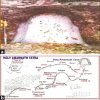Hyperglycemic emergencies in Indian patients with diabetes mellitus on pilgrimage to Amarnathji yatra
- PMID: 22701854
- PMCID: PMC3354951
- DOI: 10.4103/2230-8210.94267
Hyperglycemic emergencies in Indian patients with diabetes mellitus on pilgrimage to Amarnathji yatra
Abstract
Background: Diabetic ketoacidosis (DKA) and hyperosmolar hyperglycemic state (HHS) represent two distinct metabolic derangements manifested by insulin deficiency and severe hyperglycemia, with estimated mortality rates of 2.5-9%. In patients with type 2 diabetes mellitus (DM) controlled by diet or oral agents, DKA does not occur unless there is significant severe stress such as severe sepsis, major surgery, trauma, etc. We observed many such emergencies occurring in pilgrims.
Objective: We analyzed the data of 13 patients with DM admitted in our endocrine department with hyperglycemic emergencies during 2 years of the annual pilgrimage (yatra) to Amarnathji.
Materials and methods: We reviewed and analyzed the case records of 13 yatris with DM who were referred and admitted in our hospital with hyperglycemic emergencies during the yatra season (July-August) of 2006 and 2007.
Results: Eleven of 13 had DKA and 1 each had HHS and hypoglycemia. After initial clinical assessment and blood sampling for blood counts, electrolytes, blood gases, urinalysis, chest radiography, and electrocardiography, these cases were managed with standard protocol published by American Diabetes Association (ADA) for the management of DKA and HHS. Average blood glucose was 466 mg/dl and nine subjects had moderate to severe ketonuria. All the cases, except one, were in stable condition at the time of discharge.
Conclusion: High altitude, strenuous exertion of going uphill, withdrawal of insulin or oral hypoglycemic drugs, starvation, sepsis, and alcohol intake were recorded as predisposing factors. Therefore, there is an immense need for institution of a special health education program to all the yatris before taking the endeavor.
Keywords: Amarnath shrine; diabetic ketoacidosis; high altitude climbing; starvation; type 2 diabetes mellitus.
Conflict of interest statement
Figures
References
-
- Kitabchi AE, Umpierrez GE, Murphy MB, Barrett EJ, Kreisberg RA, Malone JI, et al. Management of hyperglycemic crises in patients with diabetes. Diabetes Care. 2001;24:131–53. - PubMed
-
- Faich G, Fishbein H, Ellis S. The epidemiology of diabetic acidosis: A population based study. Am J Epidemiol. 1983;117:551–8. - PubMed
-
- Zargar AH, Sofi FA, Masoodi SR, Laway BA, Wani AI. Clinical, biochemical and therapeutic aspects of diabetic ketoacidosis and its outcome. Saudi Med J. 1998;19:446–52. - PubMed
-
- White N. Diabetes ketoacidosis in children. Endocrinol Metab Clin North Am. 2001;29:657–82. - PubMed
-
- Zargar AH, Wani AI, Masoodi SR, Laway BA, Bashir MI. Mortality in diabetes mellitus--Data from a developing region of the world. Diabetes Res Clin Pract. 1999;43:67–74. - PubMed
LinkOut - more resources
Full Text Sources
Research Materials


